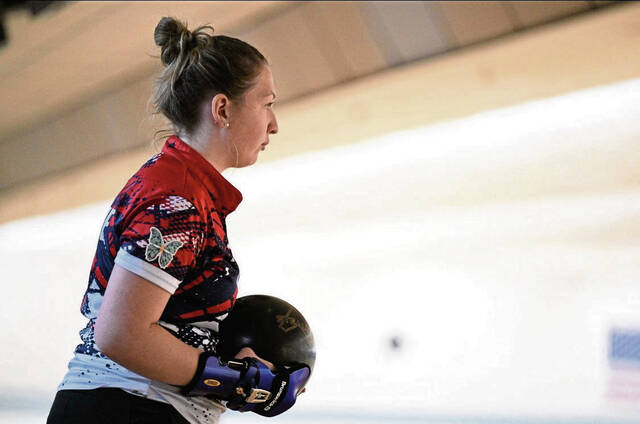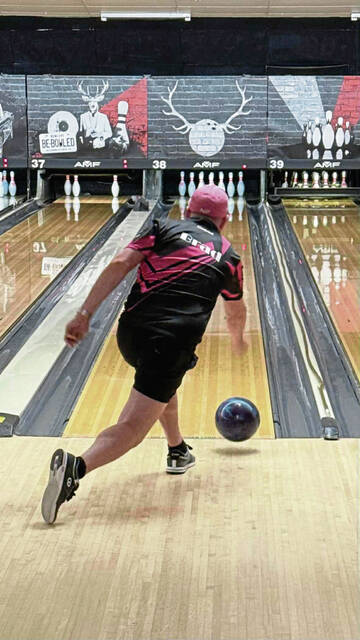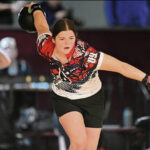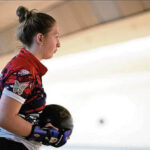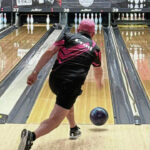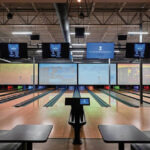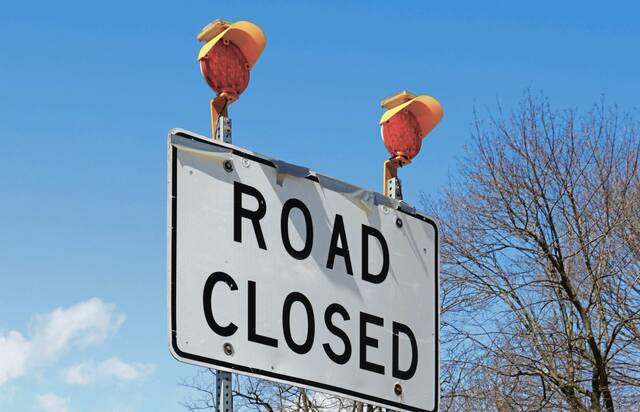It’s a ritual with which many Americans are familiar, from childhood birthday parties or adult nights out over pitchers of beer.
Put on the shoes. Choose a ball. Settle into the molded plastic seats and wait your turn to get up, scoot down to the end of the lane and — with perfect finesse and aim — throw your brightly colored ball toward the pins standing in formation at the lane’s other end.
Then — with either a triumphant jump or a laugh of embarrassment — watch your ball return and do it all over again.
According to the United States Bowling Congress, 67 million Americans bowl every year. This ranges from casual players who are looking for something different to do for fun to those in leagues and even collegiate and professional players.
But how popular is the sport in Southwestern Pennsylvania? League and collegiate players, as well as those who run leagues and tournaments, are merrily rolling along.
“I think youth bowling in general really took off. There are so many good bowlers and bowling alleys — and they all kind of teach the kids,” said Jody Fetterhoff, women’s bowling coach at Duquesne University. “It’s just bowlers loving our sport and passing that on to the next generation.”
With roots in Germany, bowling grew in popularity in the eastern United States in the 19th century, especially in areas with large German populations. The inclusion of bowling alleys in Gilded Age mansions was common in the late 19th and early 20th centuries, and the American Bowling Congress was established in 1895.
For the uninitiated, 10-pin bowling — the sport’s most popular variant in the United States — involves rolling a heavy bowling ball down a 60-foot lane to knock down as many of the 10 pins at the other end as possible. If all pins are knocked down in a first attempt, it’s called a strike; if they’re knocked down in a second attempt, it’s called a spare. A perfect game is 300 points.
Generation to generation
Many Americans first experience bowling as children, and sometimes that introduction leads to a long-term hobby or even competitive participation. This year, Westmoreland County students brought home both the boys’ and girls’ state bowling championships, and many students continue bowling on highly competitive collegiate teams.
Duquesne University, for example, has a widely recognized women’s bowling team that has attracted several star players, including Shannon Small and Emma Siekierski.
Fetterhoff has been at Duquesne for nearly a decade.
“I’ve been bowling since I was 3 years old,” she said. “I’ve been bowling my whole life. It was just something my family and I did.”
At the time, she said, high school bowling wasn’t as established as it is now.
“Bowling wasn’t nearly what it is now, so I definitely did not anticipate this as my career. It’s amazing that I get to do this every day because college bowling is just so much fun.”
Small, a fifth-year bowler at Duquesne who grew up in Plum, spent a lot of her childhood bowling at Nesbit’s Lanes.
“I’ve done it my entire life, and then with bowling came a lot of scholarship money,” she said. “I just seemed to be good at it. I was in tournaments in high school. I was pretty good, so I started getting recruited.”
“She had a phenomenal year,” Fetterhoff said of Small.
“We’re with each other so much. We practice four days a week,” Small said. She and her teammates will do workouts together and then practice their bowling skills.
Small explained that strikes are great, but being able to bowl a spare with any one or two of the pins still standing is a crucial skill for tournament success.
“You need spares to win and do well at bowling,” she said.
Siekierski, a rising senior at Duquesne, originally from Davids, Mich., also continued a parental legacy.
“My mom bowled forever ago when she was very young. Then, when my older brother and older sister got to a certain age, my mom put them in league bowling. So when I eventually got old enough to do that, my parents both worked, so it kind of worked out perfectly. The bowling alley was within walking distance of my middle school.”
Bowling became her after-school activity, and then a more serious pursuit once she got to high school. Then she chose to carry over into college competition.
“It’s been my favorite, I think, phase of bowling. … I was lucky enough to bowl for my high school team and then getting to college — I mean, it’s just really cool.”
She’s thoroughly enjoyed the camaraderie among college competitors and the understanding and seriousness of the sport at a higher level.
“We do put a lot of work into it,” she said. “The coolest part is everyone’s invested at this point and sees it for what it is, whether they’re wanting to continue it in the future at the professional level.”
To those considering joining a league or getting into the sport, Small said: “I would 100% encourage people to bowl. Even if you don’t want to bowl in tournaments, it’s a fun activity to do with your friends. You can do it any time of day in any weather.”
Casual or competitive
While there is a structured and organized side to the sport, the backbone of bowling alleys across the nation is the casual player.
One such bowler is Shawn McCoy, the league coordinator at 814 Lanes and Games in Greensburg.
“It was a date night for my wife and me, and it’s turned into much more than that,” he said.
Since then, he’s gotten into competitions and tournaments, but he remembers those easygoing roots at the beginning.
“I try to push it towards the social side of it and make it a night out where people are just going out and socializing and having fun.”
Many people may think that only older folks are in bowling leagues, but McCoy disagrees.
“It’s pretty spread out,” he said. “It’s probably the only sport I’ve seen where you can have a 20-year-old competing with a 70-year-old.”
814 Lanes and Games opened in Greensburg as an expansion from its original Johnstown location. McCoy said the place does a brisk business, especially with little ones.
“We run a program called Kids Bowl Free, a government-run program. Most of the centers in the area participate in that. It’s two free games of bowling per day for each child, and it’s free.”
The program is now celebrating its 16th year providing free bowling daily all summer long.
Michelle Maust of Crafton decided to join a bowling league in January 2024 at her local bowling alley, Bowlero.
“It was right after the holidays and I was scrolling on Facebook, and on my neighborhood Crafton page, a woman had made a post. They were looking for people to join their league, which is just for fun — you don’t have to be a good bowler.”
She and her fiancé decided to join for “something to do and to meet some new people.” Now, she’s fallen in love with the sport and looks forward to league nights every other week.
“We didn’t know anybody else who was there,” she said. “We’ve met 20-some new people that we really like. We’ve made some great new friends.”
She’s also improved her bowling game — every week, their league sets a challenge for the evening.
“My average has gone up. I’m having fun trying to meet the challenges. So I’ve definitely become a better bowler, but I am certainly not a great bowler.”
She’s even started buying her own gear — shoes and balls — instead of renting the alley’s.
“We started out just using the stuff there. Then, right away, when we decided we were going to continue, we bought our own shoes. And then, of course, I’ve picked up probably three or four balls at local thrift stores.”
She does plan to get a more professional ball drilled to fit her hand.
Also at Bowlero, Brad Dunlap rejoined an old hobby with gusto. Dunlap, of Shadyside, is a lifelong bowler who took a break for a while to finish college and start his career. He returned to the sport about a year ago and found himself getting really involved since then.
“I found out about the Stonewall Leagues, the gay sports leagues here in Pittsburgh, and me and a few friends decided to join up,” he said. “That got me addicted, and I’m now involved in two different leagues and the director of a tournament, and I travel all over the place for tournaments.”
The tournament he directs is the BARBI — ’Burgh Area Rainbow Bowling Invitational. They had their first event this year and are already gearing up for next year, a whole weekend-long tournament to be held in March 2026.
“We’re already anticipating up to 40 teams,” Dunlap said.
The tournament is open to teams, doubles and singles, and while it centers on those in the LGBTQIA+ community, it’s open and inclusive for anyone.
Between his leagues and tournaments, Dunlap bowls at least twice a week. And he’s not alone; the phenomenon of league bowling seems to be growing in popularity. For example, he said, Stonewall League’s spring league normally has space for 30 teams, but 38 signed up.
“So they had to create a whole new system of people having bye weeks and rotating out so that everyone can have a chance to bowl, because it’s such a popular sport and everybody wants to do it.”
Echoing the sentiment of everyone else, Dunlap also feels that bowling — no matter the level — is about community and enjoying oneself.
“We’ve been having drinks the whole time, we’re chatting with the people next to us. We’re there just to socialize and make friends.”
Maust echoed that sentiment.
“When you bowl, you’re not thinking about everything else. Literally, I can go there for two hours and just bowl and have fun and cheer other people on. … It’s just two hours of having fun and eating bowling alley food,” she said. “I wake up on bowling day, and I’m like, ‘Yay, it’s bowling day!’ ”




